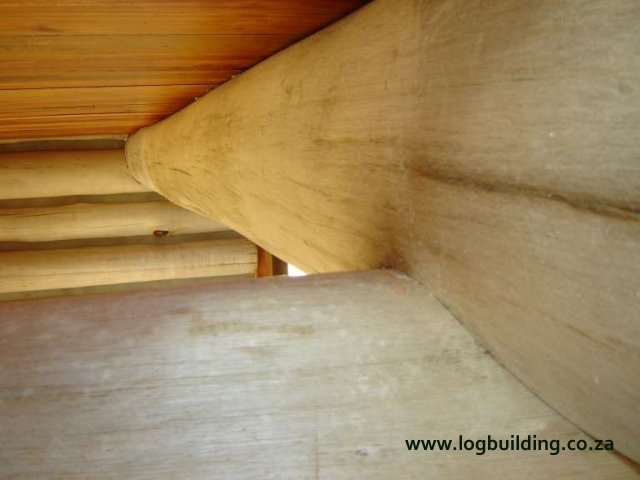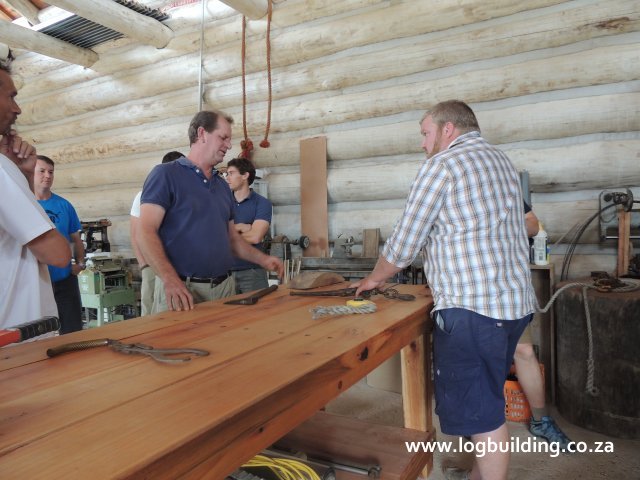Often, building or buying a house is one of the biggest personal investments that a person makes in their lifetime. If you are considering employing a contractor to build your home, I advise you to attend my course well beforehand so that you will know if the contractor is being up-front and honest with you.
I cannot stress this enough, there are contractors that do not necessarily have your best interests at heart and will tell you anything that they think you want to hear.
Without having a full understanding of this construction technique, how will you know whether they are doing a good job or not? In the end, it is your money, as the home owner, you are going to personally pay for any mistakes, errors or failures.
I would like to point out that there is an important difference between 'Genuine solid log homes' and 'Timber homes' or 'timber frame homes', even if a company claims to build 'Log homes', they are often building 'timber homes'.
Why they do this? I don't know...maybe having 'solid log' rather than 'solid plank' or just 'plank' in their name just sounds better?
Maybe 'Solid timber plank homes' just does not have the same ring to it.
A log is the trunk of a tree, 'in the round', before it is processed into timber, or dimensional lumber.
The tree is felled, the logs go to a sawmill, gets sawn up into planks, joists, beams --call it what you like, as soon as it goes through a sawmill, it is no longer a log, it is now timber or lumber.
Some well known manufacturers claim to use a 'HEAVY SOLID LOG SYSTEM', in reality their buildings look like the typical timber home picture below.
The easiest way to tell what type of construction they use is to look at the corners of their buildings, usually found in a picture gallery on their website.
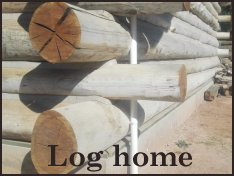
sticking out, it is a log home.
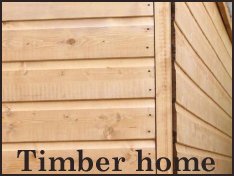
machined (even if the planks have been
machined to a rounded appearance),
it is a timber home.
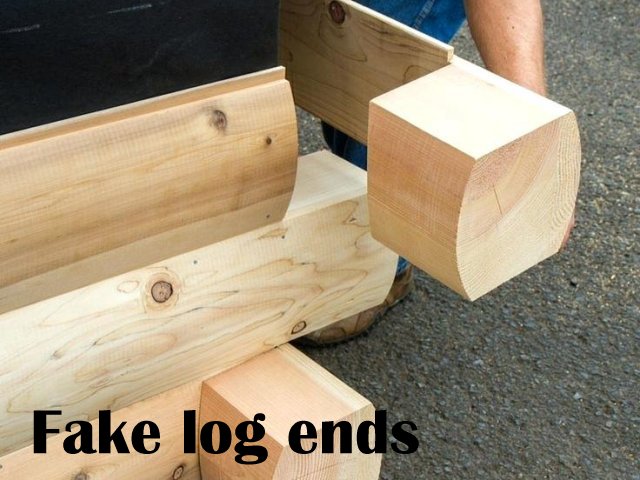
in a desperate attempt to make it look solid.
These are just thin cladding planks with
a block of wood glued onto the end.
Don't be fooled. Whatever they claim in writing, usually looking at the pictures on their website will tell you if they build genuine log homes or timber plank houses
Now that you know the difference: Please do not contact me for advice on timber homes, I do not build timber homes and I do not give advice on timber homes.
For advice on timber homes Contact these guys.
The lifespan and strength of a genuine log home is far superior to any 'timber framed home'.
I recommend building a genuine log home that has a long lifespan and minimal maintenance.
Timber framed home lifespan
The lifespan of a timber framed home is limited by it's smallest components, specifically the nails and screws that are used to hold it together. The Wiki on lumber states 'Fasteners used with treated lumber require special consideration because of the corrosive chemicals used in the treatment process.
This will be shown to be true in the following example:
A couple of points that are not commonly mentioned:
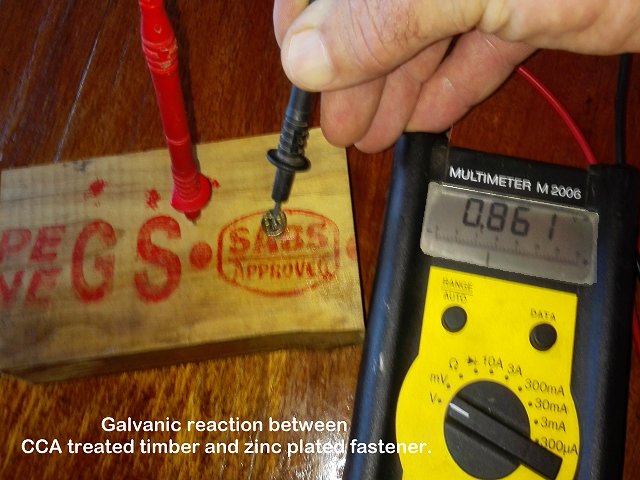 A galvanic reaction occurs between the copper in CCA treated timber and the zinc plating on the screw (you have created a 0.8 volt battery). When this occurs, the copper in the timber always wins and the fastener always loses.
A galvanic reaction occurs between the copper in CCA treated timber and the zinc plating on the screw (you have created a 0.8 volt battery). When this occurs, the copper in the timber always wins and the fastener always loses.
Moisture is required and acts as an electrolyte. (readily available on an exposed deck each time it rains)
CCA treatment is being phased out in many places and is often replaced by ACQ, it is less toxic but has two big problems.
- ACQ-treated timber is five times more corrosive to common steel.
- ACQ acts as a surfactant (wetting agent) which lowers the surface tension of water, which helps to absorb moisture, keeping that galvanic reaction going more efficiently.
My favorite South African saying in this regard is 'Goed koop is duur koop' (penny wise, pound foolish).
If you don't have the time to do it properly, when are you going to have the time to correct it?
Timber home maintenance:
Timber framed homes need constant maintenance, and in some instances require re-painting every 18 months (at great expense to you and an unnecessary waste of time and resources). If you skip this maintenance for any appreciable length of time and the paint begins to peel, you will end up having to sand down the entire house, back to bare wood and begin afresh.
If you skip this maintenance for any appreciable length of time and the paint begins to peel, you will end up having to sand down the entire house, back to bare wood and begin afresh.Some timber home manufacturers make light of this maintenance, with comments their website like.."A good scrub with a brush or hard broom and new coat of exterior timber sealant is recommended every 18-36 months.". Sounds easy, no problem, you might say.
My neighbor has an average sized 3 bedroom timber home built by a well known local contractor.
For the last 8 weeks she has had a team of workers sanding all the sealer paint off the house and re-painting it.
Out of curiosity, I asked her how much this maintenance was costing? The answer...R100 000! Every couple of years? Expensive!
How often does it need to be done? "Well, that depends", he said, anything from every 2 years if they use a 'varnish', to every 4 - 5 years if they use a 'timber preservative'. ..as often as that? Are you serious?
Many timber home builders use timber stilt foundations.
These timber stilts are in constant ground contact, moisture and bacteria, which are the worst possible conditions for timber.
The bacteria that cause timber to rot are present in the ground, all they need is moisture to do their natural work.
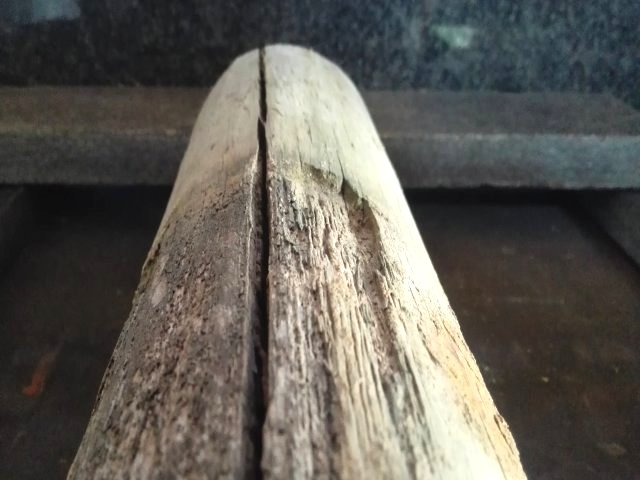
I don't think much of H4 CCA treatment, just 6 years in clay ground, already well advanced rotting.
Cost of Timber homes versus genuine Log homes:
A genuine log home can be built with your own cash.
This saves you a lifetime of slavery to the bank while repaying a mortgage.
A timber home can cost every bit as much as a brick home and usually requires a mortgage.
While you repay that mortgage, you are fully responsible for all the maintenance on a building that you do not own - add that to the cost of ownership.
A home is usually one of the most expensive personal investments that many people make in their lifetime, building a real and genuine log home can be done with your own cash.
I believe in building a house that requires the least amount of maintenance and has the longest lifespan. This has a number of obvious benefits:
- The housing stock does not need to be replaced regularly, thereby saving the planets valuable resources.
- The investment that you make can benefit your future generations.
- The cost of regular maintenance can be avoided by using sound and simple principles at the design stage.
Why trust someone else with your money, without educating yourself first?
How will you know if they are doing a proper job?
How do you know that they have your best interests at heart?
How do you know if (or more likely where) they hide mistakes?


